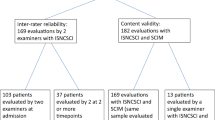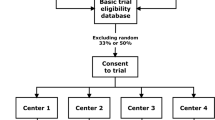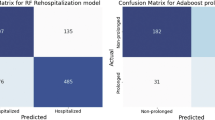Abstract
Background:
Although neoplastic spinal cord injuries (NSCIs) constitute ∼25% of all non-traumatic spinal cord lesions, patients with such pathologies are seldom, if ever, admitted to specialized centers; further, their rehabilitation typically is short because of the perception that rehabilitation prolongs hospital stays unnecessarily and is reserved only for patients with very good prognoses.
Study design:
This study is a retrospective analysis.
Objective:
The objective of this study is to evaluate the neurological and functional outcomes of patients with NSCIs compared with those of patients with traumatic spinal cord injury (TSCI).
Methods:
We evaluated 208 patients with TSCIs and 63 with NSCIs; using a matching cohorts procedure, 43 comparable couples were selected from each group. The measures used to assess these patients were the American Spinal Injury Association standards, the Barthel Index (BI), the Rivermead Mobility Index and the Walking Index for Spinal Cord Injury.
Results:
In the general population, NSCI patients are older and have longer lesion-to-admission times and more incomplete lesions than TSCI patients. Therefore, the functional status at admission and outcomes differed between the groups. In the matching cohorts, TSCI patients had lower BI scores at admission than NSCI subjects. At discharge, the two groups had comparable functional outcomes. Neurological status was similar at admission and at discharge.
Conclusions:
Although they had slightly disparate functional levels at admission, NSCI and TSCI patients had the same outcomes at discharge. Our data suggest that in a selected cohort of NSCI patients, rehabilitation is as successful as that in TSCI subjects and allows most patients to be discharged instead of being institutionalized.
Similar content being viewed by others
Log in or create a free account to read this content
Gain free access to this article, as well as selected content from this journal and more on nature.com
or
References
Cowap J, Hardy JR, A’Hern R . Outcome of malignant spinal cord compression at a cancer center: implications for palliative care services. J Pain Symptom Manag 2000; 19: 257–264.
McKinley WO, Conti-Wyneken AR, Vokac CW, Cifu DX . Rehabilitative functional outcome of patients with neoplastic spinal cord compressions. Arch Phys Med Rehabil 1996; 77: 892–895.
McKinley WO, Huang ME, Brunsvold KT . Neoplastic versus traumatic spinal cord injury: an outcome comparison after inpatients rehabilitation. Arch Phys Med Rehabil 1999; 80: 1253–1257.
McKinley WO, Huang ME, Tewksbury MA . Neoplastic vs traumatic spinal cord injury: an inpatient rehabilitation comparison. Am J Phys Med Rehabil 2000; 79: 138–144.
Zaidat OO, Ruff RL . Treatment of spinal epidural metastasis improves patient survival and functional state. Neurology 2002; 58: 1360–1366.
Parsch D, Mikut R, Abel R . Postacute management of patients with spinal cord injury due to metastatic tumour disease: survival and efficacy of rehabilitation. Spinal Cord 2003; 41: 205–210.
Eriks IE, Angenot EL, Lankhorst GJ . Epidural metastatic spinal cord compression: functional outcome and survival after inpatient rehabilitation. Spinal Cord 2004; 42: 235–239.
Catz A, Goldin D, Fishel B, Ronen J, Bluvshtein V, Gelernter I et al. Recovery of neurologic function following nontraumatic spinal cord lesions in Israel. Spine 2004; 29: 2278–2282.
Ruff RL, Ruff SS, Wang X . Persistent benefits of rehabilitation on pain and life quality for nonambulatory patients with spinal epidural metastasis. J Rehablil Res Dev 2007; 44: 1–10.
Ruff RL, Ruff SS, Wang X . Persistent benefits of rehabilitation on pain and life quality for nonambulatory patients with spinal epidural metastasis. J Rehablil Res Dev 2007; 44: 271–278.
Tang V, Harvey D, Park Dorsay J, Jiang S, Rathbone MP . Prognostic indicators in metastatic spinal cord compression: using functional independence measure and Tokuhashi scale to optimize rehabilitation planning. Spinal Cord 2007; 45: 671–677.
Fattal C, Gault D, Leblond C, Gossens D, Schindler F, Rouays-Mabit H et al. Metastatic paraplegia: care management characteristics within a rehabilitation center. Spinal Cord 2009; 47: 115–121.
American Spinal Injury Association: International Standards for Neurological Classifications of Spinal Cord Injury. American Spinal Injury Association: Chicago, 2000, 1–23 (revised).
Scivoletto G, Morganti B, Ditunno P, Ditunno JF, Molinari M . Effects of age on spinal cord lesion patients rehabilitation. Spinal Cord 2003; 41: 457–464.
Mahoney FI, Barthel DW . Functional evaluation: the Barthel Index. Mar State Med J 1965; 14: 61–65.
Collen FM, Wade DT, Robb GF, Bradshaw CM . The rivermead mobility index: a further development of the rivermead motor assessment. Int Disabil Stud 1991; 13: 50–54.
Ditunno PL, Dittuno Jr JF . Walking index for spinal cord injury (WISCI II): scale revision. Spinal Cord 2001; 39: 654–656.
Morganti B, Scivoletto G, Ditunno P, Ditunno JF, Molinari M . Walking index for spinal cord injury (WISCI): criterion validation. Spinal Cord 2005; 43: 27–33.
Osterthun R, Post MWM, van Asbeck FWA, on behalf of the Dutch-Flemish Spinal Cord Society. Characteristics, length of stay and functional outcome of patients with spinal cord injury in Dutch and Flemish rehabilitation centres. Spinal Cord 2009; 47: 339–344.
Chafetz RS, Mulcahey MJ, Betz RR, Anderson C, Vogel LC, Gaughan JP et al. Impact of prophylactic thoracolumbosacral orthosis bracing on functional activities and activities of daily living in the pediatric spinal cord injury population. J Spinal Cord Med 2007; 30 (Suppl 1): S178–S183.
Kitagawa T, Kimura T . The influence of complications on rehabilitation of spinal cord injuries: economical minus effects and physical disadvantages caused by urinary tract infection and decubitus ulcer. J Nippon Med Sch 2002; 69: 268–277.
Reitz A, Haferkamp A, Wagener N, Gerner HJ, Hohenfellner M . Neurogenic bladder dysfunction in patients with neoplastic spinal cord compression: adaptation of the bladder management strategy to the underlying disease. NeuroRehabilitation 2006; 21: 65–69.
Anzai K, Young J, McCallum J, Miller B, Jongbloed L . Factors influencing discharge location following high lesion spinal cord injury rehabilitation in British Columbia, Canada. Spinal Cord 2006; 44: 11–18.
DeJong G, Branch LG, Corcoran PJ . Independent living outcomes in spinal cord injury: multivariate analyses. Arch Phys Med Rehabil 1984; 65: 66–73.
Abrahm JL, Banffy MB, Harris MB . Spinal cord compression in patients with advanced metastatic cancer: ‘all I care about is walking and living my life’. JAMA 2008; 299: 937–946.
Helweg-Larsen S, Sorensen PS, Kreiner S . Prognostic factors in metastatic spinal cord compression: a prospective study using multivariate analysis of variables influencing survival and gait function in 153 patients. Int J Radiat Oncol Biol Phys 2000; 46: 1163–1169.
McKinley WO, Seel RT, Hardman JT . Nontraumatic spinal cord injury: incidence, epidemiology and functional outcome. Arch Phys Med Rehabil 1999; 80: 619–623.
Scivoletto G, Morganti B, Molinari M . Early versus delayed inpatient spinal cord injury (SCI) rehabilitation: an Italian study. Arch Phys Med Rehab 2005; 86: 512–516.
Tokuhashi Y, Matsuzaki H, Oda H, Oshima M, Ryu J . A revised scoring system for preoperative evaluation of metastatic spine tumor prognosis. Spine 2005; 30: 2186–2191.
Acknowledgements
This study was supported in part by grants from Ministero della Salute to M Molinari. The professional editorial work of Blue Pencil Science is also acknowledged. This work was supported in part by the Italian Ministry of Health grants and approved by the local ethics committee.
Author information
Authors and Affiliations
Corresponding author
Ethics declarations
Competing interests
The authors declare no conflict of interest.
Rights and permissions
About this article
Cite this article
Scivoletto, G., Lapenna, L., Di Donna, V. et al. Neoplastic myelopathies and traumatic spinal cord lesions: an Italian comparison of functional and neurological outcomes. Spinal Cord 49, 799–805 (2011). https://doi.org/10.1038/sc.2011.6
Received:
Revised:
Accepted:
Published:
Issue date:
DOI: https://doi.org/10.1038/sc.2011.6
Keywords
This article is cited by
-
The frequency of various spinal cord tumors (SCTs) in surgically treated patients at Shiraz Shahid Chamran Hospital from 2012 to 2022
Egyptian Journal of Neurosurgery (2023)
-
Risk factors for poor outcomes of early rehabilitation after total en bloc spondylectomy: a retrospective chart review of 140 patients
Spinal Cord (2020)
-
Challenges in rehabilitation of patients with nontraumatic spinal cord dysfunction due to tumors
Wiener klinische Wochenschrift (2019)
-
Understanding the Role of Rehabilitation Medicine in the Care of Patients with Tumor Causing Spinal Cord Dysfunction
Current Physical Medicine and Rehabilitation Reports (2017)
-
Demographic and clinical characteristics of patients with spinal cord injury: a single hospital-based study
Spinal Cord (2016)



